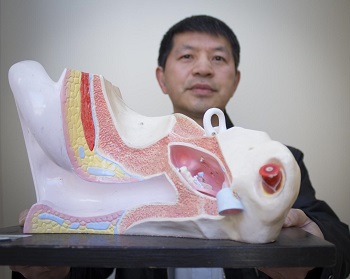University of Alberta - (Edmonton) Screening newborn babies who are in the neonatal intensive care unit (NICU) using a testing process called high-frequency tympanometry can help identify middle-ear problems earlier, according to newly published research from a local team of researchers.
"If people cannot hear, we need to know if the problem is with the middle ear, inner ear or hearing nerve. Obviously, a baby cannot tell you, so in the clinic it's hard to know when they have hearing loss," explained Ming Zhang, an associate professor at the U of A's Department of Communication Sciences and Disorders and co-author of the new study with colleagues Li Qi of Vancouver General Hospital, Brian Schmidt of Glenrose Rehabilitation Hospital, and Mosarrat Qureshi and Leonora Hendson, who both hold appointments at the Royal Alexandra Hospital and the U of A's Department of Pediatrics.

Ming Zhang holds an anatomical model of a human ear. Zhang is co-author of a study showing that testing newborns in neonatal intensive care units for middle-ear disorders can lead to earlier treatment and reduce the need for extensive followup tests. Credit: Bryan Alary / University of Alberta
"Once you know the problem is with the middle ear, we can reduce stress on parents worrying about hearing loss and putting their child through a battery of followup tests, which can take months to complete. This also allows us to concentrate treatment on middle-ear disease that much sooner."
In their study, audiologists used high-frequency tympanometry to test middle-ear function in 31 infants between the ages of one week and six months at the Royal Alexandra and Glenrose hospitals. All babies involved in the study were screened using a standard test, called auditory brainstem response, and high-frequency tympanometry.
Middle-ear impairments can be treated by various means, such as inserting a tube through the eardrum to relieve pressure issues or removing blockages of air flow into the middle ear behind the nose. Inner-ear problems, which can be the result of damage to hair cells that impairs the ability to convert sound vibrations into nerve activity, are much more complex, Zhang says, and require more extensive treatments such as cochlear implants or using hearing aids.
In cases of middle-ear disease, this tube is often blocked, and this kind of treatment of middle-ear disease can return hearing to its optimal levels.
The research team showed that high-frequency tympanometry is a good test for identifying middle-ear disorders in very young infants who are in or have recently been in the NICU. Use of this test could lead to earlier treatments and better hearing for these babies.
"Newborn screening is a priority of Canadian and American audiology and pediatric medical communities, and our study shows there is a benefit to screening the middle ear of newborns," Zhang said.
The team's findings were published June 23 in the Canadian Journal of Speech-Language Pathology and Audiology. The study was awarded the Excellence in Applied Research Award by Speech-Language & Audiology Canada, which partially funded the research.
Source: https://www.eurekalert.org/multimedia/pub/95250.php.

